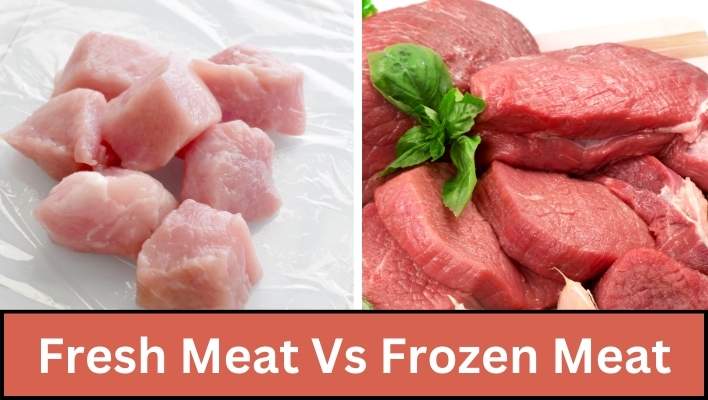Meat does not need to be frozen for second grind. Freezing is not necessary for the second grind of meat.
Freshly ground meat is a versatile ingredient used in various cooking preparations. Many people wonder if freezing the meat before the second grind is necessary to improve its texture or flavor. We will explore whether or not meat needs to be frozen for the second grind.
We will discuss the benefits and drawbacks of freezing, as well as provide insights into the best practices for achieving the desired results when grinding meat. Whether you are an avid home cook or a professional chef, understanding the role of freezing in meat grinding will help you make informed decisions and create delicious meals. So, let’s get started and uncover the truth about freezing meat for the second grind.
Ground Meat Texture: Understanding The Science Behind Freezing
When it comes to ground meat, texture plays a crucial role in the overall eating experience. Whether you’re making burgers, meatballs, or sausages, achieving the perfect texture is essential. One method that can significantly impact the texture of ground meat is freezing. Freezing ground meat not only helps with preservation but also affects its texture in fascinating ways. In this Section, we will explore the science behind how freezing impacts the texture of ground meat.
How Freezing Affects The Texture Of Ground Meat
Freezing ground meat helps optimize its texture due to two important factors: the formation of ice crystals and the breakdown of connective tissue. Let’s delve into each factor to understand their unique contributions.
The Role Of Ice Crystals In Breaking Down Connective Tissue
When ground meat is frozen, moisture within the meat forms ice crystals. These ice crystals play a significant role in breaking down the connective tissue present in the meat. Connective tissue, such as collagen, is responsible for giving meat its structure but can also contribute to toughness. The formation of ice crystals within the meat helps to break down this connective tissue, resulting in a softer and more tender texture.
Read Also: Can You Use a Meat Grinder to Make Peanut Butter?
As the meat thaws, the ice crystals will melt, leaving tiny pockets where the connective tissue used to be. This breakdown of connective tissue enhances the tenderness of the ground meat, making it easier to chew and enjoy.
Why Freezing Leads To Juicier And More Tender Ground Meat
In addition to breaking down connective tissue, freezing also helps retain the natural juices within the ground meat. When meat is frozen, the water content within the muscle fibers and cells solidifies and expands. This expansion causes the cell membranes to rupture, which in turn releases more moisture and juice when the meat is cooked.
When ground meat is thawed and cooked, this retained moisture contributes to a juicier and more succulent texture. The increased juiciness not only enhances the overall flavor but also prevents the meat from drying out during the cooking process. As a result, your final dish will be more tender, flavorful, and satisfying.
So, the next time you’re wondering whether to freeze your ground meat before giving it a second grind, remember that freezing can actually improve the texture. By breaking down connective tissue and retaining moisture, freezing ensures that your ground meat turns out juicier, more tender, and ultimately more enjoyable to eat!
The Benefits Of Freezing Meat Before The Second Grind

Freezing meat before the second grind can offer numerous benefits that not only enhance the taste and quality of your ground meat but also ensure its safety and extend its shelf life. By freezing meat, you preserve its quality and flavor, prevent the growth of bacteria and pathogens, and maximize the freshness of the ground meat. Let’s explore these benefits in more detail:
Preservation Of Meat Quality And Flavor
Freezing meat before the second grind helps to preserve its quality and flavor. When meat is frozen, the low temperature slows down the natural enzymatic processes that can degrade the meat’s texture and taste. By preventing these processes, freezing maintains the meat’s tenderness and juiciness, resulting in a superior eating experience.
Moreover, freezing meat locks in its natural juices and flavors, ensuring that they are not lost during the grinding process. When meat is ground without being frozen, some of its essential moisture and flavor may escape, leading to drier and less tasty ground meat. Freezing the meat before the second grind helps to retain these valuable attributes, enhancing the overall quality and taste of the final product.
Read Also: How Many Times to Grind Meat for Sausage
Preventing The Growth Of Bacteria And Pathogens
Another crucial benefit of freezing meat before the second grind is that it helps to prevent the growth of bacteria and pathogens. Meat naturally contains bacteria, some of which can be harmful if consumed in large quantities. Freezing meat at or below 0°F (-18°C) inhibits the growth and reproduction of bacteria, making the meat safer to consume.
In addition to bacteria, freezing also helps to control the development of pathogens like Salmonella and E. coli. These foodborne pathogens can cause severe illnesses when present in raw or undercooked meat. Freezing meat effectively halts their growth, reducing the risk of foodborne illnesses and ensuring the safety of ground meat.
Maximizing The Freshness And Shelf Life Of Ground Meat
Freezing meat before the second grind maximizes the freshness and shelf life of the ground meat. By subjecting the meat to freezing temperatures, you slow down the spoilage processes that occur over time. Freezing inhibits the activity of microorganisms that cause the meat to spoil, extending its shelf life and allowing you to enjoy high-quality ground meat for longer periods.
When properly stored in airtight packaging or freezer bags, frozen ground meat can retain its freshness and quality for several months. This means that you can batch prepare ground meat, minimizing waste and ensuring that you always have a supply of fresh meat readily available for your culinary endeavors.
Freezing meat before the second grind offers a multitude of benefits. It helps preserve the quality and flavor, prevents bacterial growth, and maximizes the freshness and shelf life of the ground meat. By taking this extra step, you ensure that each bite of your delicious ground meat is of the highest possible quality and safe to consume.
Proper Freezing Techniques For Second Grind
When it comes to the second grind of meat, proper freezing techniques play a crucial role in maintaining the quality and taste of the ground meat. Freezing the meat correctly not only helps to prevent bacterial growth but also preserves the natural flavors and textures. In this section, we will explore the key steps and best practices for freezing meat intended for a second grind.
Selecting The Right Cuts Of Meat For Grinding
When choosing cuts of meat for grinding, it’s important to pick those with a good balance of lean meat and fat content. This helps to achieve the desired flavor and moisture in the ground meat. Ideal options include chuck, sirloin, and round cuts. Selecting quality meat from reputable sources ensures better taste and texture in the final product.
Preparing The Meat For Freezing: Trimming, Cubing, And Seasoning
Before freezing the meat, it’s essential to properly prepare it. Start by trimming any excess fat or connective tissues. This not only improves the taste but also prevents the meat from becoming greasy during the grinding process. After trimming, cube the meat into smaller pieces for easier handling and freezing. Seasoning is optional at this stage, but if you wish to enhance the flavor further, you can lightly sprinkle salt, pepper, or other desired spices before freezing.
Read Also: How to Grind Meat for Baby Food: Ultimate Guide
Packaging And Labeling Tips For Efficient Storage
Efficient packaging and labeling are key to easy storage and retrieval of frozen meat. Use airtight, freezer-safe containers or vacuum-seal bags to prevent freezer burn and protect the meat from exposure to air. Label each package with the type of meat, date of freezing, and any additional seasonings used. This helps to keep track of the contents and ensures that you use the oldest stock first, maintaining freshness and taste.
Understanding Ideal Freezing Temperatures And Duration
Proper freezing temperatures and duration are crucial in maintaining the quality and safety of the ground meat. The ideal temperature for freezing meat is below 0°F (-18°C). This ensures that the meat freezes quickly and retains its freshness. As for the duration, it is recommended to store ground meat in the freezer for no longer than 3-4 months. This ensures optimal flavor and texture when it comes to using it for a second grind.
Understanding and implementing proper freezing techniques is essential for preserving the quality and taste of meat intended for a second grind. By selecting the right cuts, trimming, cubing, seasoning, packaging, and labeling correctly, as well as adhering to ideal freezing temperatures and duration, you can ensure that the ground meat maintains its flavor and quality until it’s ready to be used.
Thawing And Handling Frozen Meat For Second Grind
Thawing and handling frozen meat properly is essential to maintain the quality and safety of the meat, especially when it comes to the second grind process. Freezing meat before the second grind can help preserve its freshness and flavor, but it’s crucial to follow safe and effective methods for thawing and handling to prevent any potential cross-contamination.
Safe And Effective Methods For Thawing Frozen Meat
Thawing frozen meat properly is the key to ensuring its safety and preventing the growth of harmful bacteria. Here are some safe and effective methods for thawing frozen meat:
- Refrigerator Thawing: Thawing frozen meat in the refrigerator is the safest method as it keeps the meat at a consistent and safe temperature. Simply place the sealed meat in a shallow dish or on a tray to catch any juices, and allow it to thaw slowly in the refrigerator. It’s important to plan ahead as this method requires more time, with approximately 24 hours needed for every 2.3 to 4.5 kilograms (5 to 10 pounds) of meat.
- Cold Water Thawing: If you need to speed up the thawing process, you can use the cold water thawing method. Place the frozen meat in a leak-proof plastic bag and submerge it in cold water. Change the water every 30 minutes to ensure it stays cold. It’s important to note that this method requires constant supervision and the meat should be cooked immediately after thawing.
- Microwave Thawing: Thawing frozen meat in the microwave is another option if you’re short on time. However, it’s crucial to follow the microwave manufacturer’s instructions carefully to avoid partially cooking the meat. Use the defrost function and stop the microwave periodically to rotate and flip the meat to ensure even thawing.
- Cooking Frozen Meat: In certain instances, you can skip the thawing process altogether and cook the meat directly from its frozen state. This method is suitable for ground meat, but you should increase the cooking time by approximately 50% to ensure thorough cooking.
Tips For Preventing Cross-contamination During The Thawing Process
Cross-contamination can occur during the thawing process if proper precautions are not taken. Here are some tips to prevent cross-contamination:
- Keep meat separate from other foods: Store the frozen meat in a leak-proof bag or container to prevent juices from coming into contact with other foods.
- Use separate cutting boards and utensils: Designate specific cutting boards and utensils for handling raw meat to avoid cross-contamination with other foods. Ensure these items are thoroughly washed and sanitized after use.
- Wash hands frequently: Proper hand hygiene is crucial during the thawing process. Wash your hands thoroughly with soap and warm water before and after handling the meat.
- Sanitize surfaces: Clean and sanitize any surfaces that come into contact with the frozen meat, including countertops, sinks, and utensils, to eliminate any potential bacteria.
Handling Instructions To Maintain The Quality And Safety Of The Meat
To maintain the quality and safety of the meat during the second grind process, it’s essential to follow these handling instructions:
- Inspect the meat: Before proceeding with the second grind, visually inspect the meat to ensure there is no discoloration, off odors, or any other signs of spoilage. If any abnormalities are detected, discard the meat immediately.
- Use clean equipment: Make sure all the equipment, including the meat grinder, blades, and bowls, are clean and free from any residue or previous contaminants. Thoroughly wash and sanitize the equipment before use.
- Cut meat into smaller pieces: Cutting the frozen meat into smaller, manageable pieces can help facilitate the second grind process and ensure even grinding.
- Grind the meat at the desired temperature: Freezing the meat before the second grind can help maintain its texture and juiciness. Ensure the grinder and meat are cold throughout the grinding process by periodically placing them in the freezer or on ice.
- Store ground meat properly: Once the second grind is complete, promptly store the ground meat in airtight containers or sealed bags to maintain its freshness. Refrigerate or freeze it immediately if not using it right away.
Alternative Methods: Fresh Vs. Frozen Meat For Second Grind

When it comes to the second grind of meat, one crucial decision to make is whether to use fresh or frozen meat. Each approach has its advantages and disadvantages, so it’s essential to explore the pros and cons of both options. By understanding the different scenarios where fresh or frozen meat is preferred and following some helpful tips, you can achieve the desired texture and flavor for your ground meat.
Read Also: How To Grind Meat In A Vitamix?
Exploring The Pros And Cons Of Using Fresh Or Frozen Meat
Choosing between fresh and frozen meat for the second grind involves considering various factors. Here’s a breakdown of the advantages and disadvantages of each option:
Fresh Meat
|
Frozen Meat
|
Highlighting Different Scenarios Where Fresh Or Frozen Is Preferred
The choice between fresh and frozen meat for the second grind often depends on specific scenarios. Here are some instances where one option might be preferred over the other:
- When taste is paramount: If you prioritize natural flavors and want the freshest taste, fresh meat is the way to go. It offers unmatched flavor profiles that can elevate your dishes.
- Convenience and long-term storage: Frozen meat is an excellent choice for those who want to stock up or plan ahead, as it has a longer shelf life and allows for flexible meal preparations.
- Time constraints: If you’re short on time or need ground meat immediately, frozen meat offers convenience without compromising quality. It eliminates the need to wait for fresh meat to thaw.
- Customization and experimentation: Fresh meat provides more flexibility for experimentation and customization, allowing you to adjust the grind size and texture according to your specific recipes or preferences.
Offering Tips For Achieving The Desired Texture And Flavor With Both Options
Regardless of whether you choose fresh or frozen meat for the second grind, you can optimize the texture and flavor with a few helpful tips:
- Keep meat and equipment cold: Ensure that both the meat and grinder are adequately chilled. Cold temperatures help maintain the integrity of the meat and prevent excessive heat during grinding.
- Cut meat into uniform pieces: Before grinding, cut the meat into consistent pieces to ensure even grinding and achieve a uniform texture throughout.
- Experiment with grinding techniques: Adjust the grinder settings and grinding speed to find the sweet spot for the desired texture and consistency of the ground meat.
- Thaw frozen meat properly: If using frozen meat, thaw it in the refrigerator overnight for the best results. Avoid thawing at room temperature, as it can lead to uneven thawing and compromise the texture.
- Season and marinate as desired: Take advantage of seasonings and marinades to enhance the flavor of your ground meat. Experiment with various combinations to find the perfect balance for your dishes.
By understanding the pros and cons of using fresh or frozen meat for the second grind and considering specific scenarios, you can make an informed decision to achieve the desired texture and flavor. With the right tips and techniques, you’ll be able to enjoy delicious ground meat that complements your favorite recipes.
Read Also: Can You Use a Meat Grinder to Stuff Sausage? The Ultimate Guide
Frequently Asked Questions Of Does Meat Need To Be Frozen For Second Grind
Do You Have To Freeze Meat Before Grinding?
Yes, you should freeze meat before grinding it. Freezing the meat helps to firm it up, making it easier to grind and preventing it from smearing. Additionally, freezing the meat also helps to kill any potential harmful bacteria that may be present.
Can You Grind Meat Twice?
Yes, you can grind meat twice for a smoother consistency and to ensure thorough mixing of flavors. Grinding the meat twice helps break down connective tissues and distributes fat evenly. It’s a personal preference, but it can enhance the texture and taste of your meat dishes.
Can You Freeze Meat And Grind It Later?
Yes, you can freeze meat and grind it later. Freezing meat helps preserve its freshness and grinding it later allows for versatile usage in various recipes. Properly store the meat in airtight packaging before freezing to maintain its quality.
Is It Best To Grind Meat Thawed Or Frozen?
It is best to grind meat when it is thawed rather than frozen.
Conclusion
Freezing meat for a second grind is not mandatory, but it can provide certain benefits. Freezing helps to maintain the quality and safety of the meat by slowing down bacterial growth. It also enhances the texture and flavor of the ground meat.
However, if you plan to consume the ground meat immediately, freezing may not be necessary. Ultimately, the decision to freeze or not will depend on your specific needs and preferences.




